#spikemoss
Explore tagged Tumblr posts
Text


Fern fiddleheads, specifically Matteuccia struthiopteris, the Ostrich Fern! They look much prettier than I made them here (link).
The leaves on Ivy’s shirt is Selaginella uncinata, aka Peacock Spikemoss (not a true moss). They really are iridescent blue like peacock feathers, which is probably an adaptation to protect their cells from UV damage. When you get them wet they look more normal green and the iridescence is lost until they dry again, you can kind of see it in the picture I got from the greenhouse.
(Tagged for blood and body horror cw)
#poison ivy but she’s an actual botanist#Selaginella uncinata#spikemoss#Matteuccia struthiopteris#ferns#body horror cw#blood cw#poison ivy art#poison ivy dc#pamela isley#horror#botanical horror#art#artist on tumblr#fanart#botany
192 notes
·
View notes
Text


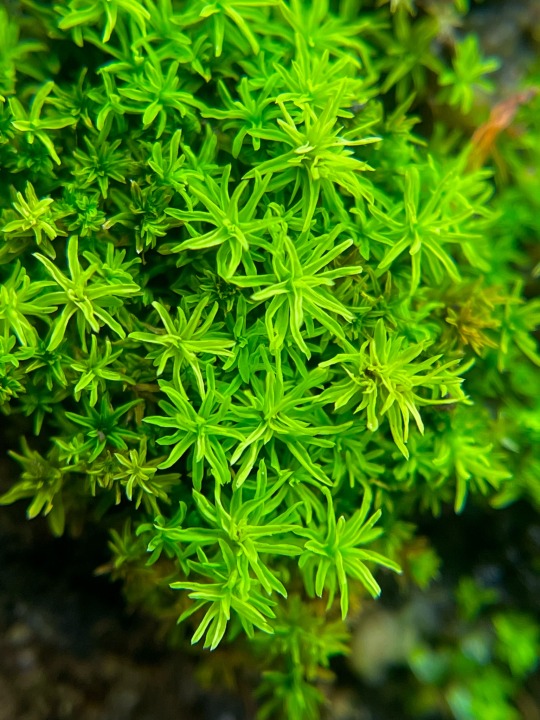

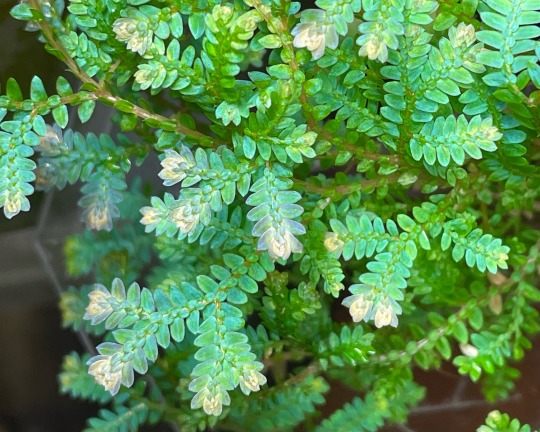
some of my lovely little plants! bryophytes & ferns might be my favorite green things
319 notes
·
View notes
Text

My 200k epic sheith fic, Spikemoss will be complete this Sunday! Absolutely thrilled to have completed it!!
If you've been waiting until it was done to jump in, your wait is finally over! It's fully tagged, but if you have any questions about any triggers, I'm happy to answer any questions in the Ask. :)
And if you'd like to tip me (omg thank you!!!!), I have a ko-fi.
#sheith#vld#spikemoss#can you believe this is finished#i still can't conceptualize not posting next friday#i've been doing this for over a year!!!#i love this story#you can tell because of how dang long it is lmao
53 notes
·
View notes
Text
#2404 - Selaginella kraussiana - Krauss's Clubmoss


AKA Selaginella azorica, Selaginella canescens, Krauss' spikemoss, African clubmoss and 'peacock fern'.
Native to the volcanic archipelagos of the Eastern Atlantic, and parts of south and east Africa. Since its introduction to Britain in 1878 it has spread slowly, and was first recorded in the wild in 1917, but an increasingly frequent greenhouse weed. Invasive in Australia and NZ, forming dense mats in shaded areas as in the photos above.
A few species of the 750 Selaginella are desert plants that curl up in a tight, brown or reddish ball during dry times, and uncurl and turn green after rain.
Lake Mangamahoe, Taranaki Ringplain, New Zealand
#Selaginellaceae#Selaginella#spikemoss#clubmoss#lycopod#lake mangamahoe#taranaki ringplain#invasive species#greenhouse weed#weed
4 notes
·
View notes
Text

Gold-tip Selaginella
#microphotography#micro photography#flora#plants#club moss#spikemoss#spike moss#terrarium#photo tag#mine
0 notes
Text








I'm queueing up a single post about one of my tanks or jars to go up every day starting with my oldest sphagnum bog tank :)
This is a layer of wet peat, distilled water only (critical for bog plants) sealed to keep all the moisture in.
Most of the growth is thick live sphagnum moss, it's turning slightly yellowy brown because it's starting to grow too close to its own light source! There are various other mosses, tiny climbing plants and three species of sundews.

The chunk of wood was once fully exposed and is now nearly swallowed up, you can see liverworts (long, translucent ribbonlike growths) coating it where it remains moist, tiny spikemosses colonizing the top where it's a little drier, and some baby sundews that sprouted directly on it!

This "well" was made by cutting a plastic water bottle in half and punching holes in the bottom. Once a year I refresh the water by pouring more in, and using a turkey baster to suck the old water back out through this well, which is helpful because a bog doesn't like too many nutrients!
119 notes
·
View notes
Text
learning and memorizing plant/protist life cycles is the worst. i dont care about spikemoss megaspores
12 notes
·
View notes
Text



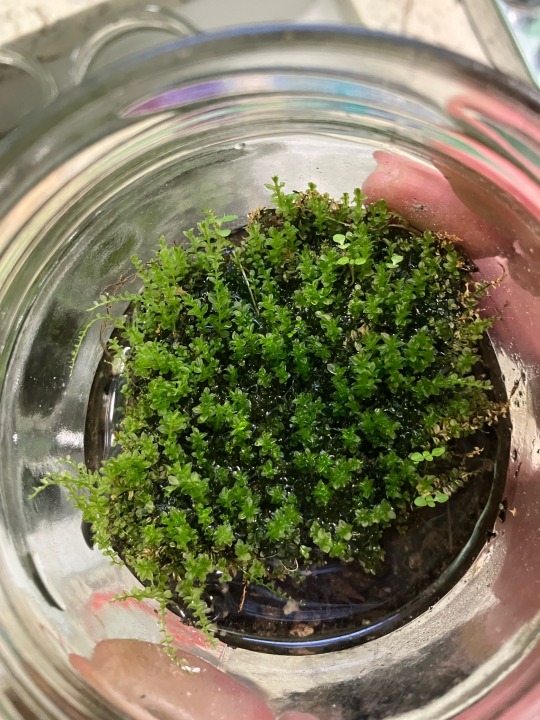
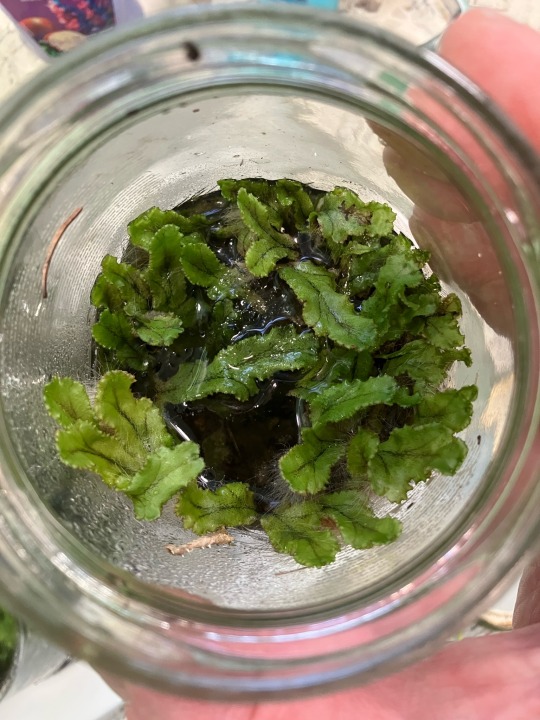


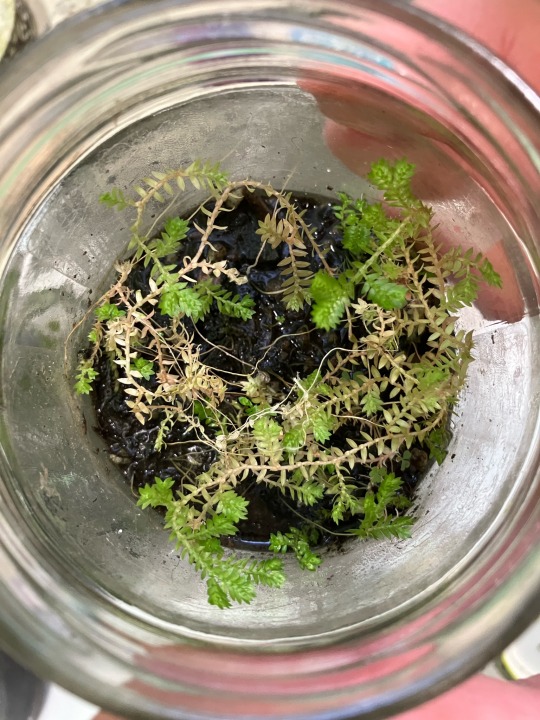
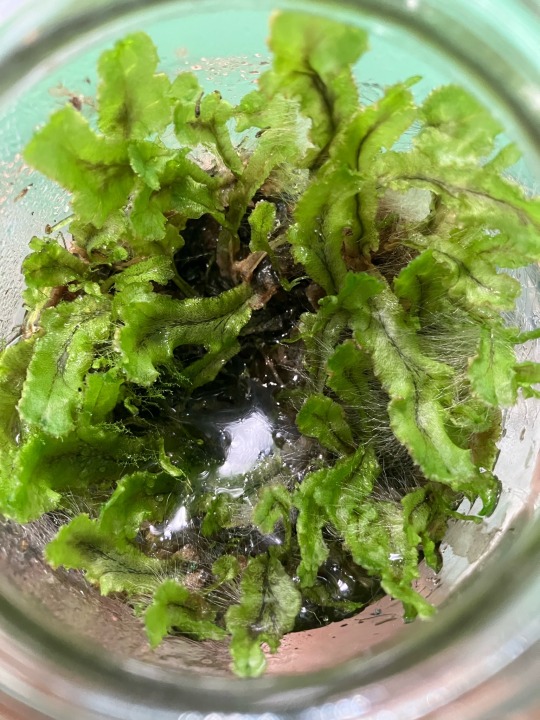

Starting off my 2024 by cleaning and refreshing my mini-terrariums of moss, spikemoss, and liverworts.
37 notes
·
View notes
Text
This is for science; I want to know how many people know what moss is!
Please reblog when you vote and indicate your reasoning in the tags or comments! I'm trying to see what a good avenue for outreach would be.
#moss#bryophytes#botany#plants#lichens#fern allies#lycophytes#peat moss#sphagnum#listen I love moss and I love science communication and I'm sad that an awesome bryologist died recently#so I've decided to make an infographic about moss#but I need to know what is good and useful to put on it#rip Nancy Guttmann Slack#coolest old lady of all time#mine
53 notes
·
View notes
Text
Crying cause I have this plant app, and it usually is pretty good at telling me the health of a plant
But it is insistent that this very wilted spikemoss is healthy
4 notes
·
View notes
Text
The gremlin ate the plant that was originally in my gifted beaver mug, so I replaced it with some spikemoss!

here’s hoping I can keep something alive that requires more watering than once a week!
4 notes
·
View notes
Text
La scoperta di un fossile in Groenlandia stupisce gli scienziati e conferma che il centro della calotta glaciale si è sciolto nel recente passato
Scaglie di gemma di salice, semi di papavero artico, corpi fungini e megaspore di spikemoss di roccia trovati nel campione di terreno GISP2 osservati al microscopio presso l’Università del Vermont. La storia della Groenlandia diventa sempre più verde e più spaventosa. Un nuovo studio fornisce la prima prova diretta che nel recente passato geologico la calotta glaciale della Groenlandia si è…

View On WordPress
0 notes
Text
El derretimiento del 90 % de este territorio en el último millón de años aumenta las predicciones de riesgo de catástrofe por la subida de nivel del mar. Restos de plantas, insectos y hongos del suelo hallados bajo tres kilómetros de hielo son pruebas inequívocas de este acontecimiento Halley Mastro observa al microscopio material vegetal antiguo procedente de Groenlandia. / Joshua Brown/UVM Por Eva Rodríguez La mayoría de la capa de hielo de Groenlandia desapareció en el último millón de años, con concentraciones de gases de efecto invernadero en la atmósfera más bajas que las actuales, por lo que es más frágil de lo que los científicos habían estimado. Esta es la principal conclusión de un nuevo estudio, publicado en la revista PNAS, que proporciona la primera evidencia directa de que el centro (no solo los bordes) de la capa de hielo de esta región se derritió en el pasado geológico reciente. La isla, ahora cubierta de hielo, albergaba entonces un paisaje verde de tundra, un hecho que aumenta de forma drástica los pronósticos de riesgo de catástrofe global por el aumento del nivel del mar si no se actúa para reducir las emisiones. Un equipo científico, coliderado por Paul Bierman, científico de la Universidad de Vermont (EE UU) y Halley Mastro, estudiante de posgrado de la misma universidad, junto con otros nueve investigadores examinaron unos cuantos centímetros de sedimento del fondo de un núcleo de hielo. Las muestras fueron extraídas en el mismo centro de Groenlandia en 1993 y conservadas durante 30 años en un depósito de Colorado. Los investigadores se sorprendieron al descubrir que el suelo contenía madera de sauce, partes de insectos, hongos y una semilla de amapola en perfecto estado. “Estos hallazgos nos dicen que la capa de hielo de Groenlandia era lo suficientemente sensible a los cambios climáticos naturales, con niveles más bajos de gases de efecto invernadero en la atmósfera que los actuales, como para derretirse casi por completo y cambiar significativamente el nivel global del mar en aquel entonces, y sabemos que los seres humanos han alterado drásticamente nuestro sistema climático desde entonces”, recalca a SINC Mastro. Escamas de brotes de sauce, semillas de amapola ártica, cuerpos fúngicos y megasporas de spikemoss de roca encontradas en la muestra de suelo GISP2 vistas al microscopio en la Universidad de Vermont. / Halley Mastro Peligros para las poblaciones costeras Si esto ocurrió sin influencia humana, ahora con un calentamiento del clima a niveles sin precedentes, el pasado está destinado a repetirse, “a menos que reduzcamos los niveles de dióxido de carbono en la atmósfera, lo que ahora es hielo pronto será agua oceánica”, advierten los autores. El derretimiento de la capa de hielo de Groenlandia contribuiría en unos seis metros de subida, ya que toda el agua encerrada en forma de hielo en tierra se liberaría y llegaría al océano. “Si ocurriera lo mismo en la actualidad, ciudades y comunidades costeras como Nueva York, Boston, Yakarta y Bombay sufrirían graves consecuencias”, alerta la científica. Bierman comenta a SINC: “Varios cientos de millones de personas se verán desplazadas por esa subida del nivel del mar, que ya ha comenzado y aumentará rápidamente a medida que el clima se caliente. Pasarán de varios siglos a varios miles de años antes de que desaparezca todo el hielo de Groenlandia. pero gran parte del calentamiento futuro ya es seguro, porque los niveles de carbono atmosférico se mantendrán altos durante decenas de miles de años”. Según los científicos, esta será la consecuencia más grave, pero, además, la pérdida de hielo en el Ártico provocará el oscurecimiento de la superficie. “La nieve y el hielo reflejan la mayor parte de la luz solar entrante enfriando el planeta. Cuando desaparece el hielo, el suelo oscuro y las plantas absorben más radiación solar y provocan un mayor calentamiento”, explica el experto. Paisaje rocoso con plantas de tundra cerca de ...
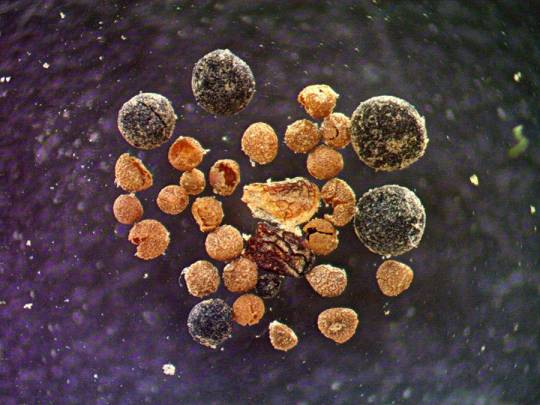
View On WordPress
1 note
·
View note
Text
Genuinely can’t believe I’m writing chapter 49/50 of Spikemoss. This has been my biggest project like.. ever?? It’s going to be over 200k by the end, and I’m shocked and excited and so grateful people liked it. It’s really meant a lot to me.
Gonna be weird soon when there’s no more to write. But at least my boy will have his happily ever after! 😭
28 notes
·
View notes
Text
youtube
Selaginella is my first choice for closed terrariums
1 note
·
View note
Text

Peacock Selaginella
0 notes